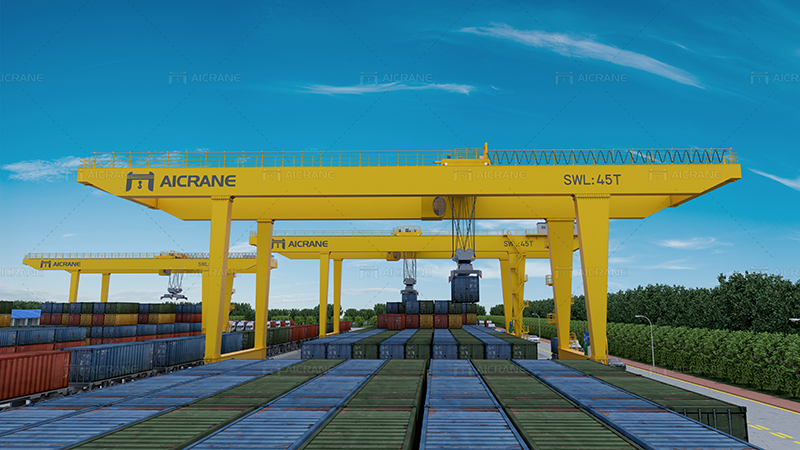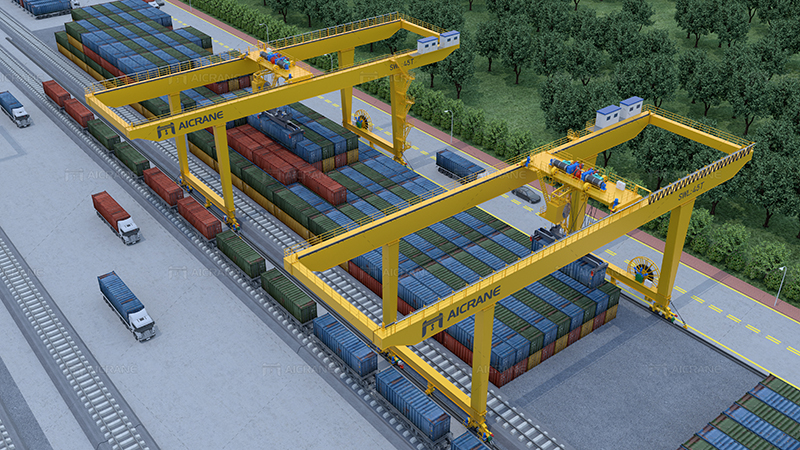Rail-mounted gantry cranes (RMGCs) play a pivotal role in modern industrial operations, especially in container handling at ports and intermodal facilities. These powerful machines are designed to efficiently lift, move, and position heavy loads with precision and speed. To make informed decisions when selecting or operating an RMGC, it’s essential to have a thorough understanding of its specifications. In this article, we will delve into key aspects of rail-mounted gantry crane specifications, shedding light on the critical factors that define their performance and capabilities.

Load Capacity
The load capacity of an RMGC is a fundamental specification that dictates the maximum weight the crane can lift and handle safely. This crucial parameter is determined by various factors, including the design of the crane structure, the strength of its materials, and the configuration of its lifting mechanism. When selecting an RMGC, it’s imperative to assess the expected load requirements and choose a container gantry crane with a capacity that comfortably accommodates these needs, ensuring optimal efficiency and safety in operations.
Span and Outreach
The span of an RMGC refers to the distance between the outer edges of the crane’s legs or rails. It plays a significant role in determining the coverage area of the crane. A longer span allows the crane to cover a larger working area, making it suitable for handling containers across multiple lanes. Additionally, the outreach, or the horizontal distance the crane’s trolley can travel beyond its rail span, is a crucial factor in reaching containers located farther from the tracks. Assessing the span and outreach is essential to ensure that the crane can effectively cover the entire operational area.
Lifting Height
The lifting height specification is a critical factor that defines the maximum elevation to which the RMGC can lift containers or other loads. This parameter is influenced by the crane’s structure, the height of its legs, and the length of its boom or lifting mechanism. It’s vital to consider the vertical space requirements of your operations and choose an RMGC with an appropriate lifting height to accommodate stacking and handling requirements.

Hoisting Speed and Mechanism
The hoisting speed of an RMGC refers to how quickly the crane can raise or lower a load. This specification is crucial for maintaining operational efficiency, especially in time-sensitive environments like container terminals. The hoisting mechanism, whether it’s a wire rope or chain, plays a significant role in determining the crane’s lifting capabilities. Understanding these rail mounted gantry crane specifications ensures that the RMGC aligns with the operational speed and efficiency requirements of the facility.
Traveling Speed and Control
Efficient movement across the rails is essential for the overall productivity of an RMGC. Traveling speed, or the speed at which the crane moves along the tracks, is a critical specification that influences the crane’s cycle time and the time it takes to reposition between tasks. Additionally, advanced control systems, such as automation and variable speed options, contribute to smoother and more precise movements. Evaluating these specifications is crucial to optimize the crane’s overall performance and reduce downtime.
Environmental Considerations
Rail-mounted gantry cranes are often deployed in challenging environments, including seaports and industrial yards exposed to varying weather conditions. Understanding the crane’s environmental specifications, such as temperature and humidity tolerances, ensures that it can operate reliably in the given conditions. Additionally, considerations like corrosion resistance and protection against harsh elements contribute to the crane’s longevity and durability.
Safety Features
Safety is paramount in material handling operations, and RMGCs are equipped with various safety features to protect both personnel and assets. Specifications related to safety include overload protection, anti-collision systems, emergency braking, and fail-safe mechanisms. Familiarizing yourself with these specifications is crucial for maintaining a secure working environment and preventing accidents or equipment failures.
Conclusion
Rail-mounted gantry cranes are indispensable in the efficient movement of containers and heavy loads within industrial settings. By thoroughly understanding the key specifications outlined above, stakeholders can make informed decisions when selecting an RMGC that aligns with their operational requirements. From load capacity to safety features, each specification plays a crucial role in determining the crane’s performance and suitability for specific applications. As technology advances, new features and innovations continue to enhance the capabilities of rail-mounted gantry cranes, making it essential for industry professionals to stay abreast of the latest developments in crane specifications. To learn more about cranes, visit https://steelmillcranes.com/
